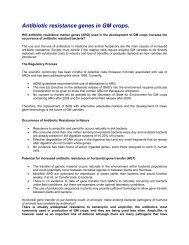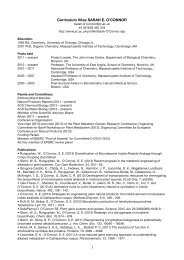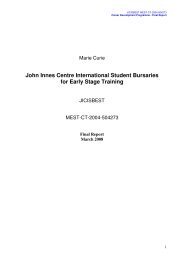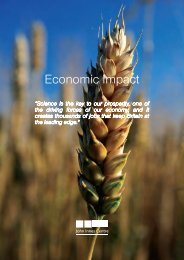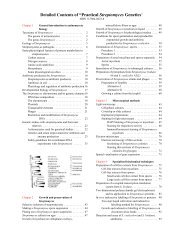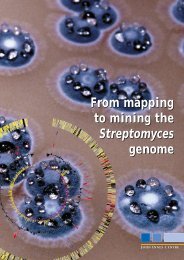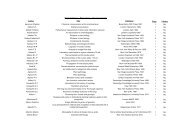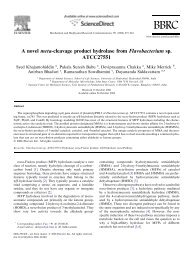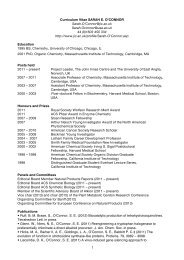1910s Timeline - John Innes Centre
1910s Timeline - John Innes Centre
1910s Timeline - John Innes Centre
You also want an ePaper? Increase the reach of your titles
YUMPU automatically turns print PDFs into web optimized ePapers that Google loves.
Students receive a regular<br />
programme of lectures during<br />
their two-year course; in 1932<br />
these are on soils and manures<br />
(Daniel Hall), Systematic Botany<br />
(E J Collins), Plant Physiology (F<br />
W Sansome), Plant Breeding (J<br />
Philp), Fruit (M B Crane) and<br />
General Horticulture (W J C<br />
Lawrence and J Newell). The<br />
lectures are supplemented by<br />
demonstrations, and students<br />
gain practical experience by<br />
working in rotation in the<br />
various ‘departments’ of the<br />
gardens. However, the scheme<br />
by which students spend three<br />
months of their training each<br />
year learning to grow<br />
ornamental plants ‘in good<br />
style’ is dropped and the<br />
ornamental plants are sold. This<br />
remains a very intensive course.<br />
JIHI’s prestige as a training<br />
establishment is reflected each<br />
year in the healthy competition<br />
for places.<br />
The JIHI gardens continue to be<br />
used for the practical<br />
examination in Horticulture for<br />
the B.Sc. (Hort.) of the<br />
University of London.<br />
1932 C D Darlington publishes<br />
Recent advances in Cytology<br />
and develops cytogenetics<br />
Darlington’s book makes an<br />
impact that is ‘immediate and<br />
world wide’. At the fifth<br />
International Genetics Congress<br />
at Ithaca, New York (1932) the<br />
leading cytologists <strong>John</strong> Belling,<br />
Curt Stern, Harry Federley and<br />
C. L. Huskins devote substantial<br />
parts of their addresses to trying<br />
to disprove Darlington’s<br />
theories. Darlington ‘was given<br />
just five minutes to defend his<br />
views, and was shouted down<br />
by a storm of critics’ (Harman,<br />
2004, p. 84). Across the<br />
cytological departments of the<br />
United States Darlington’s book<br />
is met with hostility.<br />
Darlington’s scheme of<br />
chromosome behaviour is<br />
imperfect; he has to make a<br />
priori predictions because<br />
technical difficulties mean that<br />
no preparations are available to<br />
him to test the facts directly.<br />
Leading critics, like Karl Sax at<br />
Harvard’s Arnold Arboretum,<br />
have many objections to<br />
Darlington’s generalisations and<br />
will not allow him the room to<br />
speculate without meeting their<br />
high standards of observational<br />
truth. His book is regarded as<br />
‘poison for students’. Gradually<br />
the objections are retracted and<br />
by the end of the thirties<br />
Darlington’s scheme has<br />
become scientific orthodoxy<br />
(Harman, 2004, pp. 90-94, 102-<br />
4). His innovative book<br />
ultimately secures him a world<br />
reputation as a scientist<br />
‘converting the chaos of the cell<br />
into the science of cytology’<br />
(Lewis, 1982, p. 162), and his<br />
ideas become for a time the<br />
backbone of cytogenetics, with<br />
many more geneticists adding<br />
cytological methods to their<br />
work. Darlington’s contribution<br />
also means that the evolutionist<br />
can begin to use cytogenetic<br />
work. Darlington provides<br />
powerful arguments in the last<br />
chapter of his book, ‘The<br />
evolution of genetic systems’,<br />
for placing chromosomes at the<br />
centre of evolutionary enquiry.<br />
See:<br />
A. Sturtevant and G. Beadle, An<br />
introduction to genetics,<br />
Philadelphia: W. B.<br />
Saunders,1939.<br />
D. Lewis, ‘Cyril Dean Darlington<br />
1903-81’, Heredity, 48, 2 (1982):<br />
161-7.<br />
Harman, O. S., The man who<br />
invented the chromosome: a life<br />
of Cyril Darlington, Cambridge,<br />
Mass.: Harvard University Press,<br />
2004.<br />
Page 22 of 91



